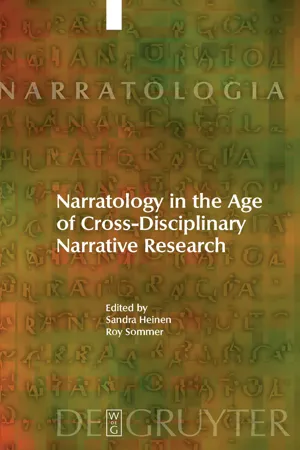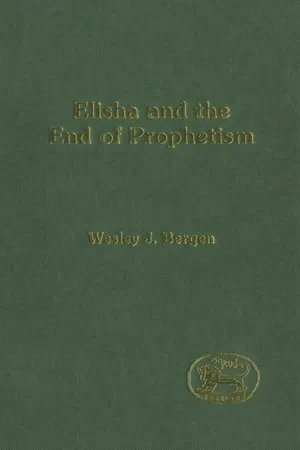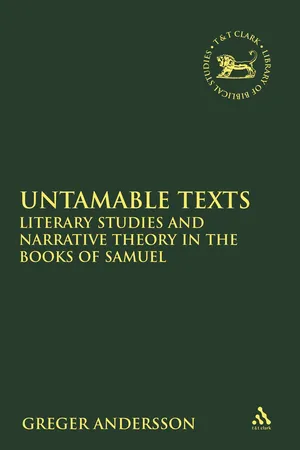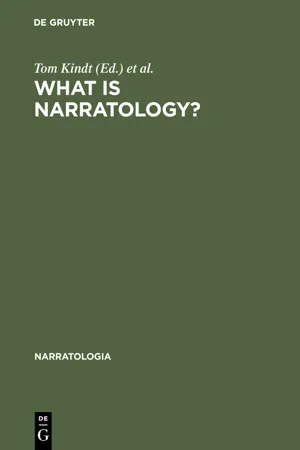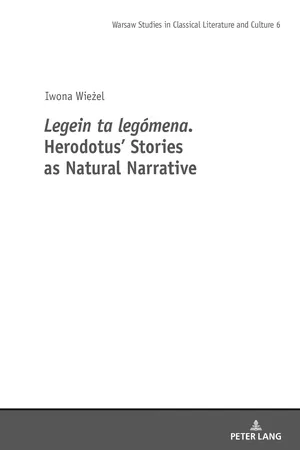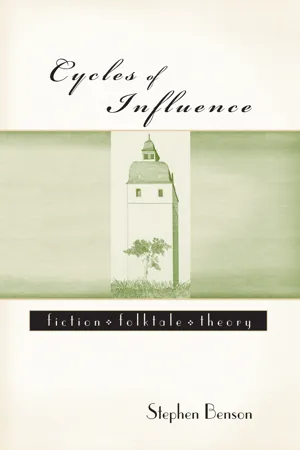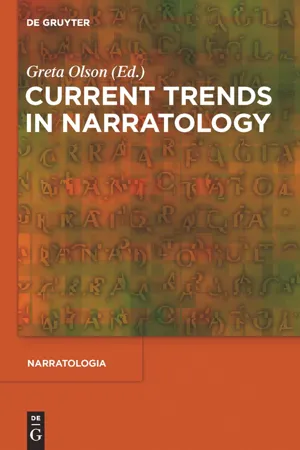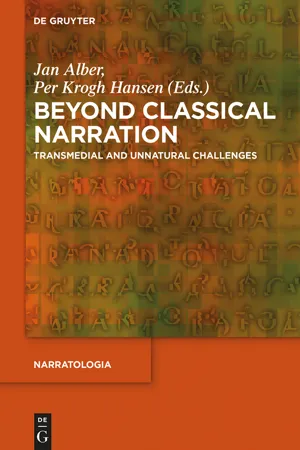Literature
Narratology
Narratology is the study of narrative structure and the principles of storytelling. It focuses on analyzing the elements of narrative such as plot, character, and point of view, as well as the ways in which stories are constructed and interpreted. By examining the underlying mechanisms of storytelling, narratology provides insights into the nature and function of literature.
Written by Perlego with AI-assistance
Related key terms
1 of 5
12 Key excerpts on "Narratology"
- eBook - PDF
- Inderjeet Mani(Author)
- 2022(Publication Date)
- Springer(Publisher)
1 C H A P T E R 1 Narratological Background 1.1 INTRODUCTION Storytelling is one of our most fundamental and familiar intellectual and social activities, with homo sapiens often characterized as the storytelling animal. The habit has been with us a long time; the cave paintings at Lascaux, dating back 17,000 years, tell their animal tales using narrative techniques including sequencing in time. While the art of narrative has been practiced since antiquity, so has its study; some of the earliest aesthetic theories pertaining to narrative include those of Aristotle (384-322 BCE) and Longinus (100 or 200 CE) in Greece and Bharata (200 BCE or 200 CE) in India. Today, guidelines for narrative construction are commonplace, with narrative concepts used informally in reviews and discussions of books, movies, plays, etc. Narratology is a theory of narrative structure, derived from literary criticism. It is “a humanities discipline dedicated to the study of the logic, principles, and practices of narrative representation” (Meister, 2011). This book tries to show how core narratological concepts can be represented in computational terms, with a view to making concepts from this extremely rich and stimulating theoretical area rel- evant and accessible to practitioners of natural language processing (NLP) and artificial intelligence (AI). For these practitioners, including those who are seeking to build better interactive systems and game environments, it is imperative to be cognizant of the field of Narratology and the theo- retical approaches that have evolved around key concepts that system developers have to represent, including character, plot, time, narrator, audience, and point-of-view. For these concepts to be made relevant to this audience, they have to be made precise and represented in computational terms. My book is thus a Narratology primer aimed at computer scientists. - Sandra Heinen, Roy Sommer, Sandra Heinen, Roy Sommer(Authors)
- 2009(Publication Date)
- De Gruyter(Publisher)
A definition of ‘Narratology’, which would be accepted by everyone, does—particularly in the wake of Narratology’s many expansions (see Her-man 1999a; Nünning/Nünning 2002a; Meister 2005)—not even exist in literary studies. Most recently this has been demonstrated by the controver-sial contributions to a volume with the programmatic title What is Narratol-ogy? (Kindt/Müller 2003a): Whereas Kindt/Müller (2003b) and Meister (2003) favour a very restrictive use of the term Narratology, Nünning (2003) suggests a differentiating, yet much broader conceptualization of different 2 The title of Barry’s article—“Narratology’s Centrifugal Force”—is therefore misleading: he uses the term ‘Narratology’ in a very broad sense denoting any form of literary narrative studies. Narrative Research across the Disciplines 195 forms of narratologies usually subsumed under the heading of postclassical Narratology. 3 In this broader understanding, postclassical Narratology has itself devel-oped into “an inherently interdisciplinary project” (Herman 1999b: 20) by turning to other disciplines in order to develop hypotheses about narrative which depart programmatically from Narratology’s earlier focus on textual features. Particularly the findings from research on natural and non-literary story-telling are increasingly incorporated into Narratology in order to refine or redefine its categories and assumptions. Prime examples are, of course, the approaches put forward among others by Manfred Jahn, David Herman and Monika Fludernik, often subsumed under the term ‘cognitive narratol-ogy’. 4 As Fludernik (2005: 47) holds, the “cognitivist paradigm shift could thus [even] pave the way for a closer companionship of Narratology with the empirical sciences”.- eBook - PDF
- Wesley J. Bergen(Author)
- 1999(Publication Date)
- Sheffield Academic Press(Publisher)
Chapter 2 Narratology Introduction Narratology, simply put, is the study of narratives. Like the study of any other specific object, it has its particular vocabulary and rules. These derive from the difference the object of study has from any other object. In this book, Narratology will be understood as a set of descriptives or concepts rather than a method. Since the object of my study is obvi-ously a narrative, it is logical to use narratological vocabulary in the study. The vocabulary acts as a set of tools but does not fully dictate the type of study which might be accomplished with these tools. 1 Much of the vocabulary in this paper is common to most of narra-tology. That which is not is taken from Mieke Bal's Narratology.2 Bal provides the most helpful introduction I have found, specifically because she proceeds from the definition of specific terms rather than from theory. This increases the intersubjectivity of the discussion. 3 This chapter is not an attempt to outline a comprehensive theory of the study of narratives, nor even of biblical narratives. Neither will I advance a 'poetics' which would attempt to describe the inner rules governing biblical narrative. These projects have already been under-taken, with greater or lesser degrees of success. Rather, the theoretical basis of my paper will be outlined in the form of defmition-through-1. While any choice of tools does limit possible interpretive activity, one might use narratological tools in feminist, deconstructive, theological or ideological analysis, to name only a few. 2. Mieke Bal, Narratology: Introduction to the Theory of Narrative (trans. Christine van Boheemen; Toronto: University of Toronto Press, 1985). 3. I am not suggesting that Bal's work is without or beyond theory but simply that her explanation begins with definition, making the set of descriptives more readily usable. - eBook - PDF
Untamable Texts
Literary Studies and Narrative Theory in the Books of Samuel
- Greger Andersson(Author)
- 2009(Publication Date)
- T&T Clark(Publisher)
20 The task was hence to study the structure common to all narratives, “the system ( la langue ) from which the innity of narrative messages ( la parole ) derives and on the basis of which they can be understood as stories in the rst place” (2005, 573). Gerald Prince provides three descriptions of Narratology in his A Dictionary of Narratology . The rst portrays the structuralist-inspired theory of narrative: “Narratology studies the nature, form, and function of narrative (regardless of medium of representation) and tries to characterize NARRATIVE COMPETENCE .” Prince explains that: “More particularly, it examines what all and only narratives have in common (at the level of STORY , NARRATING , and their relations) as well as what enables them to be different from one another, and it attempts to account for the ability to produce and understand them.” A basic assumption in this description is that narrative can be dened and that there is some kind of common structure that each individual narrative, regardless of media, is dependent on. Prince’s second description of Narratology is: “The study of narrative as a verbal mode of representation of temporally ordered situations and events (Genette). In this restricted sense, Narratology disregards the level of story in itself…and focuses on the possible relations between story and narrative text, NARRATING and narrative text, and story and nar-rating. Specically, it investigates problems of TENSE , MOOD , and VOICE .” Lastly, his third description is that Narratology involves: “The study of given (sets of) narratives in terms of narratological models and categories” (2003 [1987], 66–67). - eBook - PDF
What Is Narratology?
Questions and Answers Regarding the Status of a Theory
- Tom Kindt, Hans-Harald Müller, Tom Kindt, Hans-Harald Müller(Authors)
- 2008(Publication Date)
- De Gruyter(Publisher)
The fourth part will be devoted to a brief critique of the current proliferation of the term 'Narratology', providing both modest proposals for its future usage and a provisional map of the relations be-tween some of the key terms like narrative studies, narrative theory, nar-ratology, and narratological criticism. 2. Narratology vs. Narratologies: Differences and Tensions In his brilliant monograph Constructing Postmodernism, Brian McHale (1992: 4) makes an observation that provides an ideal starting-point, or excuse, for anyone who intends to refrain from telling 'the' story of narra-tology, being convinced that any such attempt is doomed to failure: La-tely the tables have turned, and instead of narrative being the object of narratological theory, it is theory that has become the object of narrative: where once we had theories about narrative, we now begin to have stories about theory. One of the reasons why I am reluctant to provide another story about Narratology is that the history of narrative theory arguably contradicts the critical master narratives that have so far been offered. 3 Moreover, any given story about Narratology would just trace one of the 3 Cf. Herman (1999b: 2f.); Nünning (2000a); Richardson (2000b: 170f.), who critically reviews The Narratives of Narrative Theory (170), and Bialostosky (1989: 167): 'What's the story?' we might ask. Is 'Narratology' the hero of a triumphant develop-ment, a diminished thing, or a comic character with outsized pretensions? Is narratol-ogy a converging concern of many important disciplines or a rare throwback to outmoded referential theories of literature? 242 Ansgar Nünning countless possible plots in a field that has recently turned into a garden of forking paths (Onega/Landa 1996b: 36): The actual evolution and development of narrative theory cannot begin to be grafted onto the master narrative of critical theory as told by the poststructuralists. - eBook - PDF
- John Pier, José Angel Garcia Landa, John Pier, José Angel Garcia Landa(Authors)
- 2011(Publication Date)
- De Gruyter(Publisher)
Since then, and more perhaps than any other factor, the various attempts to account for the contexts of narrative, from the sides of both production and reception, have transformed the horizons of narratological research and indeed the concept of narrative itself, bringing about a number of reorientations in perspective and closer attention to criteria previously not taken into consideration. Given these 1 The present publication was initiated at the time of the Narratology Seminar convened by us at the 7 th Congress of the European Society for the Study of English held at the University of Zaragoza in September 2004. Papers were read by Jos£ Angel Garcia Landa, Peter Hiihn, Ansgar Nünning, Beatriz Penas Ibäflez, John Pier, Michael Toolan and Jukka Tyrkkö. 8 John Pier and Jose Angel Garcia Landa evolutions, questions such as those asked above have become more prominent, and it is around narrativity, not unlike the literariness of literary theory and poetics in earlier times, that some of the most conse-quent issues in contemporary narratological research are concentrated. The attempt to define narrative as such, independent of the specific genres or of literary fiction that has dominated the study of narrative throughout its long history, was inaugurated by structuralist Narratology and continues to be a subject of debate today. 2 One of the significant con-sequences of this development, reflected in much discussion about narra-tivity, is that stories have come to be seen in a double perspective: being narrative and possessing narrativity. - Iwona Wiezel(Author)
- 2018(Publication Date)
- Peter Lang Group(Publisher)
a non-literary context of the cognitive psychology, mind philosophy, conscious- ness studies as well as biological studies of the structure and function of a human brain. Thus, inquiries into the theory of narrative are constantly complemented by practical knowledge of cognitive processes, that is, the ways information is col- lected and processed by a person. The most important directions of cognitive nar- ratology comprise currently the proposals of three scholars: Monika Fludernik, Mary-Laure Ryan and David Herman 2 . However, before we take a closer look at the natural Narratology according to Fludernik’s suggestion, it would be worth mentioning the differences between classical Narratology and the post-classical trends, also represented by cognitive Narratology. In relation to structuralist nar- ratology, they represent the following approaches: 1 Turner 2003. 2 Vide the same definition of the term “Cognitive Narratology” in LHN: http://www.lhn. uni-hamburg.de/article/cognitive-Narratology-revised-version-uploaded-22-septem ber-2013 [access on 2.02.2017]. Cf. Rembowska-Płuciennik 2012, 80–81. 26 – Contextual, thematic and ideological, – Feminist (including postcolonial, gender and queer studies), – Transmedial and trans-genre, – Cognitive and reception-oriented, – Postmodern and poststructural, – Linguistic, – Philosophical (we can also include here possible worlds theories, fiction theo- ries or phenomenology-oriented narrative theories, for example W. Iser’s or P. Ricoeur’s), – Others (for instance, studies of artificial intelligence). All these characteristics are shared by one common denominator, namely, con- text orientation, text pragmatism and reception, focusing on narrative as being textual and mental at the same time 3 .- eBook - ePub
Cycles of Influence
Fiction, Folktale, Theory
- Stephen Benson(Author)
- 2003(Publication Date)
- Wayne State University Press(Publisher)
Narratology is commonly taken to be a methodological development of structural linguistics and phonology, and the narrative raw material that I am focusing on here also has a history of being read in terms of language; indeed, a strong historical thread links the three areas of folk narrative studies, contemporaneous language studies, and narrative theory. This results from the first of the aforementioned characteristics of the folktale: its authorless, originally communal status. As Propp comments (on folk material in general), “in its origin folklore should be likened not to literature but to language, which is invented by no one and which has neither an author nor authors. It arises everywhere and changes in a regular way, independently of people’s will” (“The Nature of Folklore” 7); similarly, Jakobson repeatedly links folklore and language as products of a “collective creation” and thus comparable in certain essential respects (“On Russian Fairy Tales” 90). This link was first formulated in the early nineteenth century by Jacob Grimm, who recognized parallels between the study of the dissemination and origin of folklore and the newly developed theory of a common linguistic heritage among the family of Indo-European languages. The occurrence of similar tales in different locations could thus be explained by a common linguistic ancestry, and beginning with the second edition (1819) of the Grimms’ Kinder- und Hausmärchen, this “comparative” approach became an integral element in the study of folk narratives, instigating the analysis of folklore as a scholarly discipline. 7 As linguistic theories have developed, so opinion on the status and dissemination of folktales has also shifted, in particular away from the over-arching, holistic approaches of the nineteenth century, which stressed the search for origins and the status of the tales as fractured remnants of older myths - eBook - PDF
- Greta Olson(Author)
- 2011(Publication Date)
- De Gruyter(Publisher)
Prince 1995 Prince, Gerald: “Narratology,” in The Cambridge History of Literary Criticism. Vol-ume VIII: From Formalism to Poststructuralism , edited by Raman Selden, 110–30 (Cambridge: Cambridge University Press). Rimmon-Kenan 1976 Rimmon-Kenan, Shlomith: “A Comprehensive Theory of Narrative: Genette’s Figures III and the Structuralist Study of Fiction,” in PTL: A Journal for Descriptive Poetics and Theory of Literature 1: 33–62. Rimmon-Kenan 2002 Rimmon-Kenan, Shlomith: Narrative Fiction: Contemporary Poetics , 2 nd ed. (Lon-don/New York: Routledge). Schönert 2001 Schönert, Jörg: “‘Einführung in die Literaturwissenschaft’: Zur Geschichte ei-nes Publikationstypus der letzten 50 Jahre,” in Jahrbuch der ungarischen Germanis-tik : 63–72. Schönert 2004 Schönert, Jörg: “Zum Status und zur disziplinären Reichweite von Narratologie,” in Geschichtsdarstellung: Medien—Methoden—Strategien , edited by Vittoria Borsò and Christoph Kann, 131–43 (Köln/Weimar/Wien: Böhlau). Segal 2008 Segal, Eyal: “L’ ‘École de Tel Aviv’: Une approche rhétorico-fonctionnaliste du récit,” in Vox Poetica. Sternberg 2001 Sternberg, Meir: “How Narrativity Makes a Difference,” in Narrative 9.2: 115– 22. Sommer 2004 Sommer, Roy: “Beyond (Classical) Narratology: New Approaches to Narrative Theory,” in European Journal of English Studies 8.1: 3–11. Sommer 2004a Sommer, Roy: “‘Cross the Border—Close the Gap’: Towards an Intermedial Narratology,” in European Journal of English Studies 8.1: 81–103. Stüssel 1993 Stüssel, Kerstin: “Zwischen Kompendium und ‘Einführung’: Zur Rolle der Lehrbücher in den Geisteswissenschaften,” in Geist, Geld und Wissenschaft. Ar-beits- und Darstellungsformen von Literaturwissenschaft , edited by Peter J. Brenner, 203–30 (Frankfurt am Main: Suhrkamp). Todorov 1969 Todorov, Tzvetan: Grammaire du Décameron (The Hague: Mouton). Narratology and Codifying Texts 295 Introductions (Selection) Abbott 2002 Abbott, H. - eBook - ePub
Translation and Conflict
A narrative account
- Mona Baker(Author)
- 2018(Publication Date)
- Routledge(Publisher)
Introducing narrative theoryThe notion of narrative has attracted much attention in a wide range of disciplines, and has accordingly been defined in a variety of ways. This chapter will draw primarily on social and communication theory to elaborate a definition of narrative that is particularly suited to investigating the way in which translators and interpreters function in situations of conflict. I start with an overview of the status and effects of narrativity, including its relationship to genres, science, categories, fact and fiction, and conclude with a discussion of the political import of narratives and the way in which narrative both reproduces existing power structures and provides a means of contesting them.2.1 The status and effects of narrativityMany scholars, especially in literary studies and linguistics, tend to treat narrative as an optional mode of communication, often contrasting it with argumentation or exposition. Approaches that treat narrative as an optional mode tend to focus on the internal structure of orally delivered or literary narratives – in terms of phases, episodes and plots, for instance – and to stress the advantages of using narrative, rather than other modes of communication, to secure the audience’s commitment and involvement. The best and most influential example of this tradition is Labov. A very brief summary of his approach might help clarify important differences between literary and linguistic approaches to narrative and the broadly sociological approach adopted in this book.Labov defines narrative as ‘one method of recapitulating past experience by matching a verbal sequence of clauses to the sequence of events which (it is inferred) actually occurred’ (1972: 359–60; emphasis added), and what he calls a ‘minimal narrative ’ as ‘a sequence of two clauses which are temporally ordered - eBook - ePub
A Narratology of Drama
Dramatic Storytelling in Theory, History, and Culture from the Renaissance to the Twenty-First Century
- Christine Schwanecke(Author)
- 2022(Publication Date)
- De Gruyter(Publisher)
Given the history of Narratology, it is ignorant, highly reductive, and even grossly negligent to confine narratological analysis to drama’s story level. It is precisely, as Manfred Jahn argues, not just “the story dimension of drama […] that admits of narratological analysis” (2001, 667). Examining plays and their idiosyncratic dramatic narration, one has ask both ‘which’ story is presented and ‘how’ it is presented, with which (dramatic or narrative) means it is constructed, and in which ways. To enquire into a play’s dramatic narration is to analyse its paradigmatic and syntagmatic arrangement, its story and its ‘discourse level,’ 20 independently of its grade of narrativity. Narratology, especially transgeneric Narratology, is thus arguably a discipline from whose perspective plays that display a high grade of narrativity can be as meaningfully and fruitfully analysed as a play with a low grade of narrativity (but instead perhaps a greater dramatic quality or theatricality). This study, therefore, is part of that narratological scholarship that argues in favour of broadening the universe of narratological discourse (cf. Sect. 1.2, 3.3) to include what in pre-transgeneric and pre-transmedial Narratology, but also in contemporary handbooks for students, 21 has been seen as the opposite of Narratology’s ‘proper’ object of study: that is, drama and dramatic narration (Fig. 6). To illustrate: Starting from the ‘classical objects’ of Narratology (as symbolised by the examples in the red boxes in Fig. 6), such as narrative text, Narratology has become open to including transmedial ‘matters’ (as symbolised by the green boxes in Fig. 6), such as video game narratives, their stories, and their discourses. Now efforts have to intensify to theorise transgeneric objects of interest as well (as symbolised by the blue boxes in Fig. 6), especially drama and dramatic narration. Fig - eBook - ePub
Beyond Classical Narration
Transmedial and Unnatural Challenges
- Jan Alber, Per Krogh Hansen, Jan Alber, Per Krogh Hansen(Authors)
- 2014(Publication Date)
- De Gruyter(Publisher)
This study seeks to give insight into heretofore intangible issues and a more nuanced understanding of the narrative potential of literary reportages. Storytelling and the use of narrative strategies are fundamental means by which journalists give meaning to their reportages. But what exactly do scholars mean when they speak of the narrative dimension of literary reportages? I will address this issue with the help of the following research questions (RQs):- RQ 1: Which categories of narratological analysis (e.g. voice, mood, temporal order, narrative space, characterization) are applicable to and figure most prominently in selected literary reportages?
- RQ 2: Which categories are constitutive of and employed predominantly in different types of literary reportages (e.g. Event reportages, Milieu reportages, Portraits, Participant reportages)?
By examining these issues the study aims to add on narrative theory and to close a gap in extant transgeneric narratological research by combining feature analysis which “stresses the exact description of the individual narrative elements in their respective particularity” (Stanzel 1984: 54) with systematic narrative theory which “attempts to clarify the correspondences and connections between the separate narrative phenomena” (ibid.). In this context, the applicability to and predominance of narratological categories in literary reportages as well as the predominance of analytical categories in different types of literary reportages will be tested.Literature Review
The recent “explosion of activity in the field of narrative studies” (Herman 1999: 1) lets Kreiswirth (1995), Isernhagen (1999), and Richardson (2000) inter alia speak of a “narrative turn” in the Human Sciences, and of a renaissance of narratological analysis. Current trends in Narratology are instigated by endeavors into transgeneric, intermedia, and interdisciplinary approaches to narrative (Ryan 2004). This novel line of research is known for examining narrative elements—or in the words of Prince (2008: 19) “narrativehood”—across genre and media (Currie 1998). Nünning and Nünning (2002) argue that narrativity is not constrained to literary fiction but instead can be found in both fictional and non-fictional genres, including semi-literary journalistic texts.
Index pages curate the most relevant extracts from our library of academic textbooks. They’ve been created using an in-house natural language model (NLM), each adding context and meaning to key research topics.

